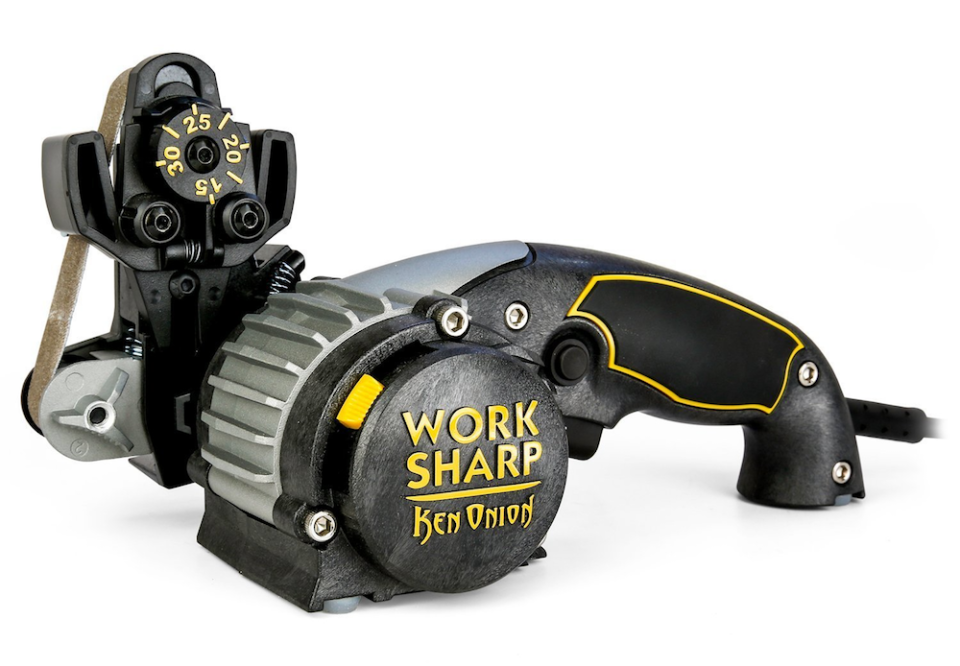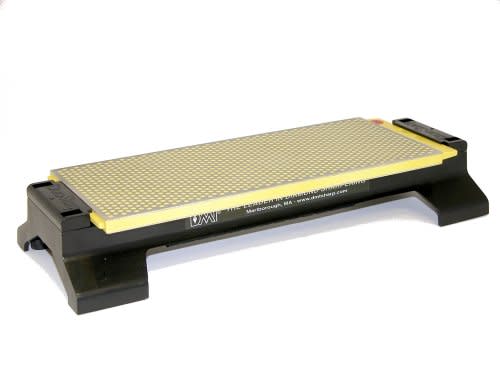The Best Ways to Sharpen Knives, According to Chefs and Knife Experts

“I like the Japanese knives, I like French knives. Whatever’s sharp,” Wolfgang Puck once said in an interview.
Knives are essential tools in every kitchen, but what do you do when yours start to lose their edges? We checked in with chefs and experts for their knife sharpening tips—from easy-DIY tips to more professional methods.
Related: The Best Kitchen Knife Sets
DIY
For those who prefer a DIY approach to knife sharpening, Claudia Sidoti, head chef at HelloFresh, has a few ideas to share, the first of which is using a piece of sandpaper: "The best size will depend on the knife and how much you want to sharpen it,” Sidoti says. She suggests starting with a coarser sandpaper and working your way up to a finer piece for maximum sharpness. Another of her methods is using a nail file, running the cutting edge of the knife blade against it.
Honeycomb Design Diamond Whetstone Grindstone Tool, $11 at amazon.com
Double Sided Diafold Sharpener Fine / Coarse, $34 at amazon.com
In a pinch, you can also grab a mug for sharpening. "Turn the mug upside down, find the raw part of the cup (the rougher part of the bottom), and run the knife across the mug until you get your desired edge," Sidoti says. She says that you will notice discoloration on the mug, which means the ceramic is removing steel and sharpening the blade.
Chef Jeff Osaka from 12 @ Madison in Denver is also a proponent of the mug method—he recommends slowly pulling the edge of the knife at about a 45-degree angle along the unglazed area. Chef Nicholas Tang of DBGB DC learned a similar technique from his grandmother, using unglazed base of a porcelain bowl instead.
“If I’m stranded with a painfully—and dangerously—dull knife, say in an Airbnb, I use the non-sharp edge of one knife as a ‘steel’ to sharpen the sharp edge of another,” explains Chef Mary Sue Milliken of Border Grill in Las Vegas and Los Angeles. “Hold the sharp edge at a 15-degree angle to the dull edge and give each side a few swipes. It always make the knife better—but never makes it a sharp knife.”
Tools of the Trade
“The easiest way to sharpen a knife is to use a knife sharpener,” says Executive Chef Fabio Capparelli from Saltine and Varia in Norfolk, Virginia. “I personally use an electric one that is called Work Sharp, the Knife & Tool Sharpener, Ken Onion Edition. It is very easy to use, and you can adjust the sharpening belt to the angle that is required for your knife."
Work Sharp Knife & Tool Sharpener, Ken Onion Edition, $129 at amazon.com

Like a Pro
“For those that are up for the art that is knife sharpening, love rolling up their sleeves and learning a new craft, I'd recommend DMT's DuoSharp Bench Stone in the Extra Fine/Fine grit, assuming your knives aren’t blunt objects that need a lot of sharpening work,” said Eunice Byun, co-founder and CEO of Material. Eunice adds that the stone can be used on a multitude of different knife shapes and sizes.
DMT 10-Inch DuoSharp Bench Stone, $117 at amazon.com

Executive Chef Garrett Merck from The Ballantyne Hotel in Charlotte, North Carolina, explains, “All sharpening works the same, regardless of the type of stone used. You will guide the knife down the stone at your desired angle multiple times. It is essential, however, that each stroke is the same—as in, same stroke pattern and pressure. The angle that you put on a knife is referred to as a bevel. If you desire a sharp knife, your angle will be much lower, as in a 15-degree as opposed to a 25-degree. If you are looking for a long-lasting edge, increase the angle.”
Learn From the Pros
Korin hosts knife sharpening classes at its flagship in New York City, taught by in-house expert Vincent Lau; there’s an online video series, too. Executive Chef Severin Nunn of The Omni Homestead Resort in Hot Springs, Virginia says, “Korin has a great video series on how to sharpen knives. I recommend watching the video multiple times.”
If you would rather leave the knife sharpening to the pros, Chef Erik Niel from Easy Bistro & Bar and Main Street Meats in Chattanooga, Tennessee suggests calling Coutelier in New Orleans or Nashville and sending your knives in to be professionally sharpened. “They are amazing, and the only people I trust to fix or sharpen my knives.”
When it comes to DIY, using a tool of the trade, or sharpening like a pro, Eunice Byun reminds us, “Regardless of which route you choose, keeping your knives sharp is critical so don't get swept up by which method. Just do what works for you and keeps those blades razor sharp.”

